Roof is the upper most portion of the building which protects the building from rain, wind and sun.
Various types of roofs used may be divided broadly into three types:
1. Flat roofs 2. Pitched roofs
3. Shells and folded plates.
Flat roofs are used in plains where rainfall is less and climate is moderate. Pitched roofs are
preferred wherever rainfall is more. Shells and folded plate roofs are used to cover large
column free areas required for auditoriums, factories etc. Brief description of these roofs is
presented below:
1. Flat Roofs: These roofs are nearly flat. However slight slope (not more than 10°) is given to drain out the rain water. All types of upper storey floors can serve as flat roofs. Many times top of these roofs are treated with water proofing materials-like mixing water proofing chemicals in concrete, providing coba concrete. With advent of reliable water proofing techniques such roofs are constructed even in areas with heavy rain fall.
The advantages of flat roofs are:
(a) The roof can be used as a terrace for playing and celebrating functions.
(b) At any latter stage the roof can be converted as a floor by adding another storey.
(c) They can suit to any shape of the building.
(d) Over-head water tanks and other services can be located easily.
(e) They can be made fire proof easily compared to pitched roof.
The disadvantages of flat roofs are:
(a) They cannot cover large column free areas.
(b) Leakage problem may occur at latter date also due to development of cracks. Once leakage problem starts, it needs costly treatments.
(c) The dead weight of flat roofs is more.
(d) In places of snow fall flat roofs are to be avoided to reduce snow load.
(e) The initial cost of construction is more.
(f) Speed of construction of flat roofs is less.
Types of Flat Roofs: All the types listed for upper floors can be used as flat roofs.
2. Pitched Roofs: In the areas of heavy rain falls and snow fall sloping roof are used. The slope of roof shall be more than 10°. They may have slopes as much as 45° to 60° also. The sloped roofs are known as pitched roofs. The sloping roofs are preferred in large spanned structures like workshops, factory buildings and ware houses. In all these roofs covering sheets like A.C. sheet, G.I. sheets, tiles, slates etc. are supported on suitable structures. The pitched roofs are classified into
(a) Single roofs (b) Double or purlin roofs
(c) Trussed roofs.
(a) Single Roof: If the span of roof is less than 5 m the following types of single roofs are used.
(i) Lean to roofs (ii) Coupled roofs
(iii) Coupled-close roof (iv) Collar beam roof
In all these roofs rafters placed at 600 mm to 800 mm spacing are main members taking load of the roof. Battens run over the rafters to support tiles. Figure 8.13 shows various types of single roofs.
(b) Double or Purlin Roofs: If span exceeds, the cost of rafters increase and single roof becomes uneconomical. For spans more than 5 m double purlin roofs are preferred. The intermediate support is given to rafters by purlins supported over collar beams. Figure 8.14 shows a typical double or purlin roof.
(c) Trussed Roof: If span is more, a frame work of slender members are used to support sloping roofs. These frames are known as trusses. A number of trusses may be placed lengthwise to get wall free longer halls. Purlins are provided over the trusses which in turn support roof sheets. For spans up to 9 m wooden trusses may be used but for larger spans steel trusses are a must. In case of wooden trusses suitable carpentry joints are made to connect various members at a joint. Bolts and straps are also used. In case of steel trusses joints are made using gusset plates and by providing bolts or rivets or welding.
Depending upon the span, trusses of different shapes are used. End of trusses are supported on walls or on column. Figure 8.15 shows different shapes of trusses used. Figure 8.16 shows a typical wooden truss details and Fig. 8.17 shows the details of a typical steel truss.
Shells and Folded Plate Roofs: Shell roof may be defined as a curved surface, the thickness of which is small compared to the other dimensions. In these roofs lot of load is transferred by membrane compression instead of by bending as in the case of conventional slab and beam constructions. Caves are having natural shell roofs. An examination of places of worships built in India, Europe and Islamic nations show that shell structures were in usage for the last 800 to 1000 years. However the shells of middle ages were massive masonry structures but nowadays thin R.C.C. shell roofs are built to cover large column free areas. Figure 8.18 shows commonly used shell roofs.
Advantages and Disadvantages of Shell Roofs
Advantages of shell roofs are:
(a) Good from aesthetic point of view
(b) Material consumption is quite less
(c) Form work can be removed early
(d) Large column free areas can be covered.
Disadvantages are:
(a) Top surface is curved and hence advantage of terrace is lost.
(b) Form work is costly.
Folded plate roofs may be looked as slab with a number of folds. These roofs are also known as hipped plates, prismatic shells and faltwerke. In these structures also bending is reduced and lot of load gets transferred as membrane compression. However folded plates are not so efficient as shells.
Figure 8.19 shows typical folded plate roofs.
Advantages and Disadvantages of Folded Plate Roofs Over Shell Roofs
Advantages are:
(a) Form work required is relatively simpler.
(b) Movable form work can be employed.
(c) Design involves simpler calculations.
Disadvantages are:
(a) Folded plate consume more material than shells.
(b) Form work can be removed after 7 days while in case of shells it can be little earlier.
Roof Coverings for Pitched Roofs
Various types of covering materials are available for pitched roofs and their selection depends upon the climatic conditions, fabrication facility, availability of materials and affordability of the owner. Commonly used pitched roof covering materials are:
(a) Thatch (b) Shingle
(c) Tiles (d) Slates
(e) Asbestos cement (A.C.) sheets ( f ) Galvanised iron (G.I.) sheets
(a) Thatch Covering: These coverings are provided for small spans, mainly for residential buildings in villages. Thatch is a roof covering of straw, reeds or similar materials. The thatch is well-soaked in water or fire resisting solution and packed bundles are laid with their butt ends pointing towards eves. Thickness varies from 150 mm to 300 mm. They are tied with ropes or twines to supporting structures. The supporting structure consists of round bamboo rafters spaced at 200 mm to 300 mm over which split bamboos laid at right angles at close spacing. It is claimed that reed thatch can last 50 to 60 years while straw thatch may last for 2025 years.
The advantage of thatch roof is they are cheap and do not need skilled workers to build them. The disadvantages are they are very poor fire resistant and harbour rats and other insects.
(b) Shingles: Wood shingles are nothing but the split or sawn thin pieces of wood. Their size varies from 300 mm to 400 mm and length from 60 mm to 250 mm. Their thickness varies from 10 mm at one end to 3 mm at the other end. They are nailed to supporting structures.
They are commonly used in hilly areas for low cost housing. They have very poor fire and termite resistance.
(c) Tiles: Various clay tiles are manufactured in different localities. They serve as good covering
materials. Tiles are supported over battens which are in turn supported by rafters/trusses etc.
Allahabad tiles, Mangalore tiles are excellent inter-locking tiles. They give good appearance also.
(d) Slates: A slate is a sedimentary rock. Its colour is gray. It can be easily split into thin sheets.
Slates of size 450 mm to 600 mm wide, 300 mm long and 4 to 8 mm thick are used as covering materials of pitched roofs in the areas where slate quarries are nearby. A good slate is hard, tough, durable. They are having rough texture and they give ringing bell like sound when struck. They do not absorb water.
(e) A.C. Sheets: Asbestos cement is a material which consists of 15 per cent of asbestos fibres evenly distributed and pressed with cement. They are manufactured in sufficiently large size.
The width of a A.C. sheet varies from 1.0 to 1.2 m and length from 1.75 to 3.0 m. To get sufficient strength with thin sections they are manufactured with corrugation or with traffords [Fig. 8.20]. They are fixed to the steel purlins using J-bolts. The roofing is quite economical, waterproof. However not very good thermal resistant. They are commonly used as covering materials in ware houses, godowns or for larger halls. In auditorium etc., if these sheets are used, false ceilings are provided to get good thermal resistance.
( f ) G.I. Sheets: Galvanised iron corrugated sheets are manufactured in the sizes 1.0 to 1.2 m wide and 1.65 m length. Galvanisation of iron makes them rust proof. They are fixed to steel purlins using J-bolts and washers. They are durable, fire proof, light in weight and need no maintenance. They are commonly used as covering materials for ware houses, godown, sheds etc. Table 8.6 gives comparison between GI and AC sheets for roof covering.

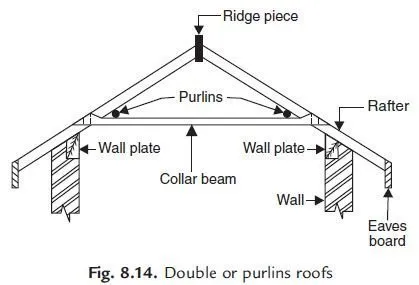
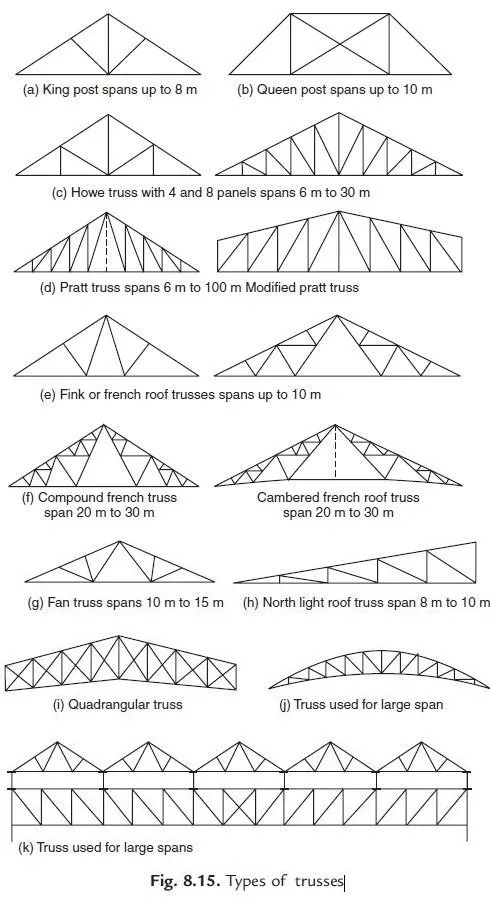





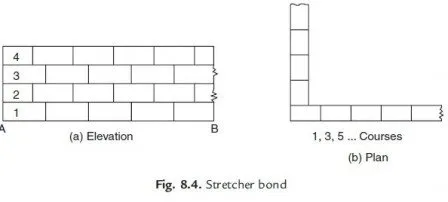


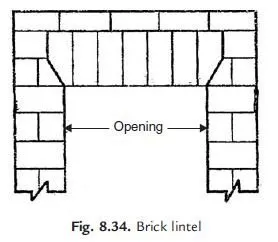
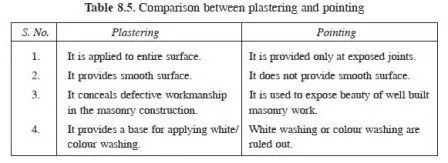
nice post but i want to know which type of roof or sheet is better in rainy areas. which one works good in these regions. ?
what are the advantages of a double pitched steel roof frame over the monopitched steel roof frame. thanks in anticipation.
i always get the best from you people braaaaaaaaaaavo.
Defects of timber and its preventive measures in roof member
can show as figure of flat roof